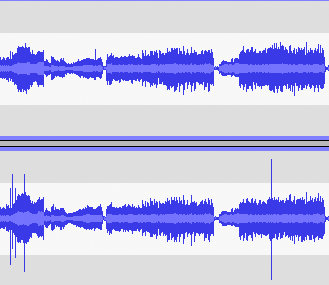and now a word from Our President:
I’ve graded records for a long time, ever since the brick and mortar days when they sat in bins. I’ve always thought that was one way to indicate their condition to the guy thinking about buying them. Obviously, if that shopper is flipping through the bins, he or she can inspect records themselves but mail order customers can’t do that, regardless of the platform where the mail order ad was shown.
This is about the record grading on this site (and at other platforms). Traditionally, someone describing a record could grade it visually, or play grade it (playing and listening). Both have their arguments, strengths, and potential pit falls.
Play grading is arguably a little better method: if you can tell somebody that you’ve listened to something, it carries a little more authority than if you can only tell them that you’ve looked at it. But play grading is really slow. Obviously somebody is constrained to sit and listen while the record plays, probably somewhat loudly (even if he or she doesn’t personally like it). If a typical record collection is maybe two hundred records, it would take a dealer a little over eight days of working without sleep or any other kind of pause to process that collection if he worked really fast.
I’ve begun to make digitized samples of my records and have been adding those to the catalog at a somewhat steady pace of a couple of them a day on a good day.
Something recently occurred to me while I was editing sound clips. In the waveform (a visual graph-like image of the recorded passage generated by a program), I can SEE clicks. And I can look through a waveform much faster than I can sit and listen to the recording because I can zoom it and fast forward it and reverse through it. And in one view, I can see an entire album, both sides, on one screen.
That means that if I use a hybrid method of playing the record and then examining its recorded digital print at a later time, I’m still constrained by the playing time of the albums, but I can also be doing other things while I record them and that’s a meaningful speed-up.
I can make Internet-ready samples of those clips with a few clicks, something already set in progress.
Here’s a very short waveform image:
You can see a pronounced spike in the bottom track at the right side: that’s a click. There’s also some noise on the left side of that track, as well as a little pop in the top track toward the left side.
There are really only two grades of records and the rest of the grades are cosmetic (visual, and subjective). Those two real criteria are: does the record click (or have other surface noise not inherent to the medium) or doesn’t it? I can tell in one glance into which category this one falls. That’s a vast improvement over listening to it for thirty to forty minutes, so after I take a couple of additional quick steps (identifying other passages like that, observing the cosmetics), I can go on to the next record.
Of course, there’s more to it than just grading the record, and even more if you’re maintaining a web site. So far, I’ve tried to supply copious photos of album covers, optimally four of five of each for an album, a couple more if it’s a double one. And the data like catalog number, year of release, the track list and so forth. There’s a little bit of time managing the database all this stuff goes into, and moving files to the site and managing them there, and all that other stuff. That’s generally considered to be not anybody’s problem but the merchant’s, so we’re not going to break that down here, but trust me, it’s “in there”.
Time is money. Anything that makes grading faster AND more useful has to be a no-brainer.
So that’s what’s going on over here in the record department. I think it’s pretty revolutionary. The last thing to think about might be the nomenclature: should I just mention in record templates that they’ve been “computer graded”, or should I invent a little twist on the regular notation? Let’s say it’s a VG+ record. Would it be ridiculously confusing to call that CVG+?
